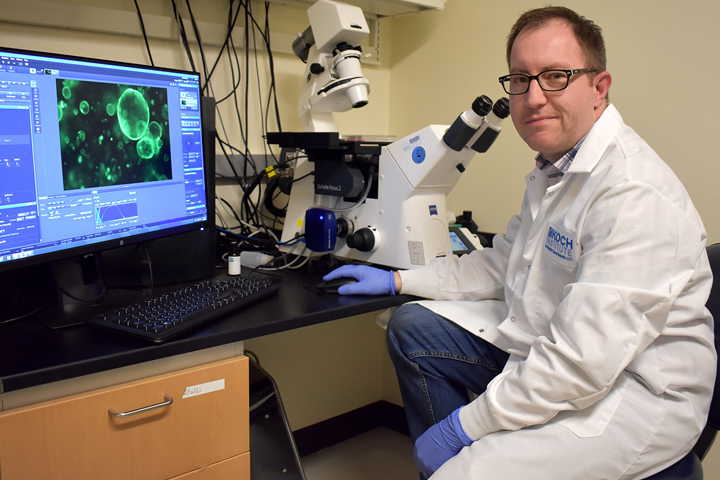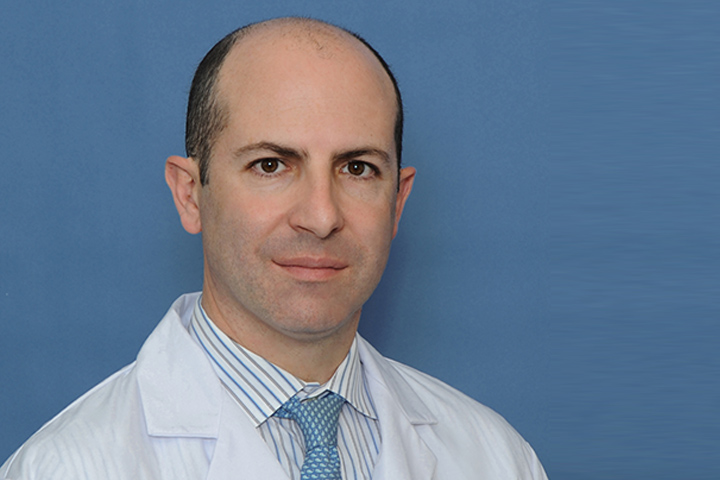Triple Immunotherapy Shows Dramatic Results

Sitting in an MIT library one evening studying for his recertification exam, William Freed-Pastor, M.D., Ph.D., couldn’t help but be awed by how immunotherapy has improved the lives of certain cancer patients.
A type of immunotherapy called checkpoint inhibitors has fundamentally changed the treatment paradigm for certain cancers, most notably melanoma and lung cancer, providing more durable responses for many patients. The same can’t be said for pancreatic cancer patients, a situation that is particularly frustrating for physician–scientists like Freed-Pastor who specialize in treatment of the disease.
Checkpoint inhibitors are specific drugs that target proteins like PD-1 or PD-L1. PD-1 is a checkpoint protein on immune cells called T cells that normally acts as a type of “off switch,” keeping the T cells from attacking other cells in the body, explains Freed-Pastor, a medical oncologist at Dana-Farber Cancer Institute in Boston, Massachusetts, and a postdoctoral fellow at the Koch Institute for Integrative Cancer Research at MIT.
PD-1 accomplishes its job when it attaches to PD-L1, a protein on some normal and some malignant cells. When PD-1 binds to PD-L1, it basically tells the T cell to leave the other cell alone. Some cancer cells, like those of non-small cell lung cancer or melanoma, have large amounts of PD-L1, which helps them hide from an immune attack.
“While reading about the biomarkers that are being used to predict which patients will respond to immunotherapy in other cancer types, I got this idea of searching for alternative ligands, other proteins, in pancreas cancer that might hit other inhibitory receptors instead of PD-L1,” says Freed-Pastor.
Out of that casual musing, Freed-Pastor and his colleagues at the Lustgarten Foundation Pancreatic Cancer Research Laboratory at MIT systematically developed a new immunotherapy strategy that combines three drugs that help boost the body’s own immune defenses against tumors.
In preclinical trials, pancreatic tumors shrank in about half of the test subjects. In 25 percent, the tumors disappeared completely. Plus, the tumors did not regrow after the treatment was stopped, explains Freed-Pastor, lead author of the study.
A Different Type of Brake
Our immune system is very elegant. And very complex. T cells patrol the body continually, looking for invaders like disease or infection. When T cells come across another cell, they have the unique ability to “peer inside” a cell by examining the peptides presented on the surface of that cell in a protein complex known as MHC class I. It’s these surface peptides that can give away the cell’s identity as either infected or cancerous. If the cell is deemed normal and healthy, the T cell moves on, looking for other cells to probe.
But if the cell is deemed infectious or diseased, the T cell initiates a kind of call to arms, enlisting the help of other immune cells to destroy the invader. It also calls on other specialized cells that prevent the immune fight from damaging normal cells in the body. These specialized cells are called immune checkpoints—their job is to regulate the immune response so it doesn’t get out of control. However, cancer cells can be wily, and they often arm themselves with proteins of normal cells. In fact, they often use immune checkpoint proteins such as PD-L1 to suppress and evade an immune system attack, essentially blinding T cells to their presence.
This is where checkpoint inhibitors come into play. They block these normal proteins on cancer cells, or the proteins on T cells that respond to them. The goal is to allow T cells to recognize the cells as cancerous and then destroy them.
One hypothesis as to why checkpoint inhibitors don’t seem to work as well in pancreatic cancer compared to other tumor types involves cancer proteins called neoantigens. Some scientists surmise that pancreatic cancer simply doesn’t produce as many neoantigens as other cancers. If so, T cells have fewer targets to attack. And even if these T cells were stimulated by checkpoint inhibitors, they wouldn’t be able to identify and destroy the tumor cells.
However, some recent studies have shown, and the MIT study (published in August) confirmed, that many pancreatic tumors do in fact express cancer-specific neoantigens. This finding led the researchers to suspect that a different type of brake, other than the PD-1/PD-L1 system, was disabling T cells in pancreatic cancer patients.
A Receptor Called TIGIT
In this study, the MIT researchers confirmed that PD-L1 is not highly expressed on pancreatic cancer cells. But they found that most pancreatic cancer cells express a protein called CD155, which activates a receptor on T cells known as TIGIT. When TIGIT is activated, the T cells enter a state known as “T cell exhaustion,” in which they are unable to mount an attack on pancreatic tumor cells. In an analysis of tumors removed from pancreatic cancer patients, the researchers observed TIGIT expression on T cells isolated from patient tumors, and they also found high levels of CD155 on patients’ tumor cells.
“What we found is the CD155/TIGIT axis functions in an analogous manner to other immune checkpoint pathways,” explains Freed-Pastor. “TIGIT is expressed on these T cells and works like a brake on those T cells. So when a TIGIT-positive T cell comes across a cell expressing high levels of CD155, it can essentially shut that T cell down.”
The Next Step: Finding the Right Drug Combination
The question remained how best to stimulate the so-called “exhausted” T cells so they could attack pancreatic cancer cells. “We tested various combinations of drugs, each of which hit the immune system at different places,” says Freed-Pastor. The regimen found to be most effective combined CD40 agonist antibodies with both a PD-1 inhibitor and a TIGIT inhibitor. CD40 agonist antibodies, some of which are currently being clinically evaluated to treat pancreatic cancer, are drugs that activate T cells and drive them into tumors. While neither TIGIT- blocking antibodies nor CD40 agonist antibodies are approved by the Food and Drug Administration yet, they have each reached phase II clinical trials.
“The results were very dramatic,” Freed-Pastor notes, “and I would be lying if I said we weren’t excited.” But he is quick to point out that more work needs to be done. “I think we all temper our excitement for multiple reasons,” he says. “We don’t know yet how this will work in humans, but we are clearly very excited about our mouse studies. All three of the drugs have been tested in humans individually, so it’s a no-brainer to test in combination.”
A clinical trial is currently in development, and what’s clear to Freed-Pastor is that people are very eager for more effective pancreatic cancer treatments.
“I get probably about two to three emails a day asking when a clinical trial is going to open,” he says. “Family members are looking for options. Patients are looking for options. I understand the need. I lost my mom to pancreatic cancer when I was a kid. So I know that people will try to move heaven and earth to find better options for those they love.
“We don’t know yet if this therapy will be a better option, but we are hopeful that it might prove to be beneficial for a subset of patients. And the only way to find out is through a clinical trial.”






